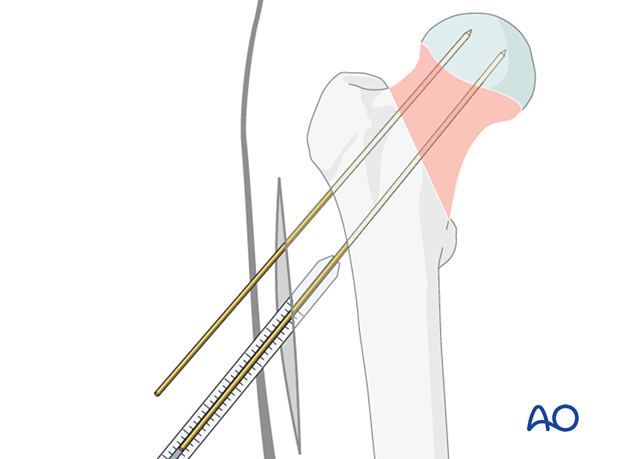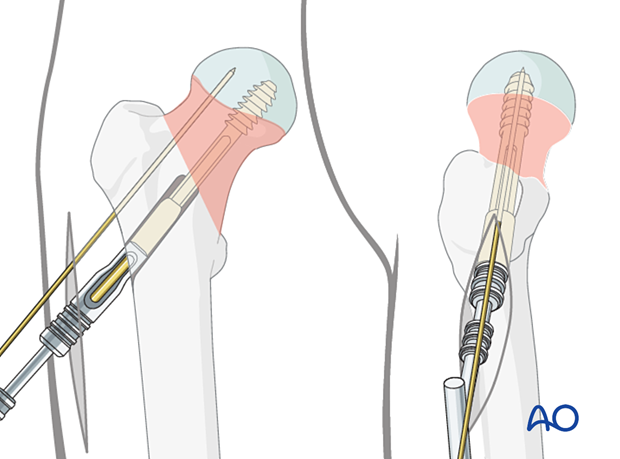Sliding hip screw with antirotation screw
1. General considerations
Introduction
An implant like a sliding hip screw (dynamic hip screw; DHS) provides angular-stable fixation combined with a cannulated screw (antirotation screw) parallel to the DHS lag screw.
It must be parallel in order not to block the sliding property of the DHS implant.
The insertion of an antirotation screw is necessary to provide sufficient rotational stability.

Throughout this treatment option illustrations of generic fracture patterns are shown, as four different types:
A) Unreduced fracture
B) Reduced fracture
C) Fracture reduced and fixed provisionally
D) Fracture fixed definitively

Treatment principles of neck fractures in combination with hip dislocation
Most of these combined injuries result from high-impact trauma in young patients. The treatment goal is to reduce the hip and achieve anatomical reduction and stabilization of the femoral neck fracture.
If there is late complication with AVN, revision surgery with total hip arthroplasty should be considered.
Closed vs open reduction
Fracture reduction should start with a closed attempt.
If manipulation does not lead to a satisfactory reduction, a percutaneous reduction technique should be performed.
The definitive decision for the treatment will be made after positioning the patient and an initial closed reduction. Since emergency department x-rays are often of suboptimal quality, verifying the preoperative diagnosis using image intensification is necessary.
Correct position of lag screw
The thread of the lag screw needs to end in the trabecular bone structures to gain enough purchase. Therefore, it is important that the lag screw comes to lie in the center of the head-neck axis or slightly inferior to it. This allows for increased depth of the screw.

Implant selection and preoperative planning
Spiral blade vs lag screwThere is not yet a clear indication of when to use a spiral blade and when a lag screw. It is, therefore, often surgeon’s preference.
In a young patient with hard bone, a blade is relatively contraindicated, and a screw should be used instead (with tapping).
In elderly patients, the use of a blade does compact the bone.
Generally, for femoral neck fractures, a two-hole DHS plate is enough.

A plate with a short barrel (illustration on the right) may be used if the lag screw length is ≤ 75 mm to allow for sliding.
A short barrel should only be considered if its end would impinge dense cancellous bone in the head.

For proper insertion of the implant, determine the optimal neck-shaft angle on the basis of the contralateral intact proximal femur. This is usually 130° or 135° depending on the patient.
If this is not available due to previous hip-joint replacement or improper AP view with external rotation of the proximal femur, provisionally reduce the fracture before draping under traction and assess the reduction quality. If acceptable, measure the angle from the AP view after reduction.

AO teaching video
Femur, Proximal – Trochanteric Fractures – Stabilization Using the Dynamic Hip Screw (DHS) and a Demonstration Exercise Using DHS in Combination with the Universal Locking Trochanter Stabilizing Plate (ULTSP)
(26 minutes)
2. Patient preparation
If the surgeon wishes to freely move the leg for reduction, the patient can be positioned supine on a radiolucent operating table. A fracture table can be used if the surgeon thinks that reduction can be obtained through the traction device on a fracture table.
C-arm image intensifier control during surgery is a must.
To obtain appropriate lateral and axial views of the hip and proximal femur, the contralateral leg is best placed in a leg holder in flexion but can be scissored into hip extension.
For C-arm positioning to acquire optimal AP, lateral, and axial views, read the additional material on:

3. Reduction
Closed reduction
Closed reduction is usually achieved by:
- Pulling in the direction of the long axis of the leg to distract the fragments and regain length
- Adjustment of internal rotation of the femoral shaft ...

... until the patella is facing forward on an AP view of the knee joint

Check the reduction in both the AP and lateral view with an image intensifier.

Assessment of reduction quality
Read the fracture line on the image intensifier views. Identify gaps or increased density due to overlapping of fragments.
Follow the medial and lateral cortical lines on the AP view and the anterior and posterior cortical lines on the axial view. Identify any translational or angular malalignment.
Acceptable reduction quality shows the following patterns:
In the AP view:
- Continuous medial and lateral cortical lines
- No varus angulation
In the lateral view:
- Normal anteversion
- No retroversion
- Continuous anterior and posterior cortical lines
The cortical lines should show intact Lowell’s S-patterns (“lazy S”) in both views.
For more details, see the additional material on assessment of reduction quality.

Percutaneous reduction
If closed reduction is not satisfactory, carry out a percutaneous reduction technique.
Open reduction
If closed reduction fails, carry out an open reduction.
A two-window approach is most commonly used: reduction and preliminary fixation with reduction forceps through a Smith-Petersen approach and a separate lateral approach for implant insertion.
Alternatively, reduce and stabilize the fracture through an anterolateral (Watson-Jones) approach. Reduction maneuvers and visualization can be more difficult through this approach.

After the capsulotomy is performed, apply traction on the limb and manipulate the head and neck with hooks or K-wires, which can be inserted to act as joysticks until an anatomical reduction is achieved.
Confirm the reduction with the image intensifier.
Temporarily stabilize the fracture with K-wires.

Alternatively, insert a Schanz screw through the lower part of the greater trochanter. This allows for traction and rotation of the distal fragment.
Insert two to three K-wires parallel to the head-neck axis for preliminary stabilization.

4. Approach for implant insertion
If the reduction has been performed closed or percutaneous, perform a limited lateral approach with an incision large enough to insert the implant and cortical screws.
5. Guide-wire insertion
Insertion of antirotation wire
To avoid rotational displacement during screw insertion, place an antirotation wire parallel and proximal to the head-neck axis.
If a K-wire used for temporary fixation is in an appropriate position, this can be used instead.

Application of the aiming device
Place the appropriate aiming device so that the screw trajectory runs slightly inferior and parallel to the head-neck axis.
This ensures that the tip of the lag-screw thread ends in the trabecular bone structures and allows for insertion of the antirotation screw.
Check its position with the image intensifier in AP, lateral, and axial views. In all views, the trajectory should be in line with the head-neck axis.

Insertion of a guide wire for the screw
Insert the guide wire through the aiming device and advance it into the subchondral bone of the head. Stop the insertion only 5 mm short of the joint. This helps prevent guide-wire pullout during reaming.
Position it so that in the AP view, it is slightly inferior to the neck-head axis and in the lateral and axial view in the center of the head-neck axis.


6. Screw insertion
Determination of lag-screw length
Determine the length of the lag screw with the help of the measuring device. Select a screw that is 5–7 mm shorter than the measured length.

Reaming
Adjust the cannulated triple reamer to the chosen length of the screw.
Slide the reamer over the guide wire and simultaneously drill for the lag screw, ream for the plate barrel, and countersink for the plate-barrel junction.

Insertion of the femoral neck screw
In patients with hard bone, it is best to tap for the screw. Otherwise, the screw may not advance, and you may displace the fracture by twisting the proximal fragment as you attempt to insert the screw.
Mount the correct screw on the handle and insert it through the centering sleeve over the guide wire. By turning the handle, it is advanced into the bone. Do not push forcefully to avoid distraction of the fracture.
The antirotation wire may help to avoid rotational displacement.
When the screw has reached its final position – 5–7 mm short of the subchondral bone in the AP and lateral view – the T-handle of the insertion piece should be parallel to the axis of the proximal femur to ensure the correct position of the plate.

7. Fixation of the DHS plate
Application of the DHS plate
Take the plate with the previously chosen neck-shaft angle, slide it over the guide wire, and mate it correctly with the screw.
Push it in over the screw and seat it home with the impactor.

Plate fixation
Fix the plate to the femoral shaft with an appropriate number and size of cortical screws.

8. Insertion of antirotation screw
To achieve maximal stability, insert a partially threaded cannulated screw parallel to the DHS lag screw over the antirotation wire (if this is in the correct trajectory).

9. Final assessment
Confirm fracture stabilization and implant position on AP, lateral, and axial views.

10. Aftercare
Postoperative mobilization
The elderly patient may start with weight bearing as tolerated with walking aids the day after surgery.
Initial restricted weight bearing is required for the young patient. This can be reassessed at 6 weeks.
Unrestricted range-of-motion exercises of the hip joint are allowed.

Pain control
To facilitate rehabilitation and prevent delirium, it is important to control the postoperative pain properly, eg, with a specific nerve block.
VTE prophylaxis
Patients with lower extremity fractures requiring treatment require deep vein prophylaxis.
The type and duration depend on VTE risk stratification.
Follow-up
Follow-up assessment for wound healing, neurologic status, function, and patient education should occur within 10–14 days.
At 3–6 weeks, check the position of the fracture with appropriate x-rays.
Recheck 6 weeks later for progressive fracture union.
Longer follow-up, at 6 months and 1 year, is indicated to assess the development of posttraumatic arthritis and/or avascular necrosis.
Implant removal
There is a high risk of a femoral neck fracture after implant removal. Therefore, this is not recommended.
Prognosis of proximal femoral fractures in elderly patients
For prognosis in elderly patients, see the corresponding additional material.













